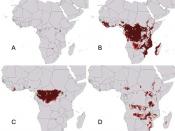Ebola
In the world today, there are many known deadly viruses, but few present as great a threat as Ebola. Key factors in understanding Ebola HF include: Its history, plan of attack, and the diagnosis and treatment of the disease.
The Ebola virus is a member of the negative stranded RNA viruses known as filoviruses. The Ebola virus is closely related to the Marburg virus. Both are members of a relatively new family of viruses called Filoviradae. There are four different strains of the Ebola virus - Zaire, Sudan, Tai, and Reston. Each is named after the geographical location in which it was discovered, but all give their victims the same painful, often lethal symptoms. They are very similar except for small serological differences and gene sequence differences. The Reston Strain is the only one which does not affect humans. The Ebola virus was named after the Ebola River in Zaire, Africa after its first outbreak in 1976.
Ebola hemorrhagic fever is classified as a BSL-4 (biosafety level 4) agent, which is the most dangerous in the Centers for Disease Control and Prevention (CDC) classification system. BSL-4 agents are exotic agents that pose a high risk of life-threatening disease, and for which there is no vaccine or therapy. "Ebola hemorrhagic fever is a severe, often-fatal disease in humans and non-human primates (monkeys and chimpanzees) that has appeared sporadically since its initial recognition in 1976" (CDC 1).
The Ebola virus can, and usually does cause a disease called Ebola hemorrhagic fever, which is a viral hemorrhagic fever. According to the proceedings of the 4th National Symposium on Biosafety, the clinical definition for Viral hemorrhagic fever is as follows. "Viral hemorrhagic fever is an acute infection that begins with fever, myalgia, malaise and progresses to prostration. It shows evidence of vascular dysregulation...


